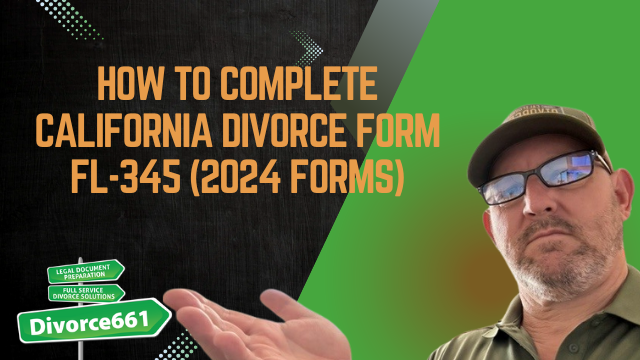How To Complete California Divorce Form FL-345 (2024 Forms)
Filing for divorce in California can feel overwhelming, especially when it comes to dividing assets, debts, and property. Fortunately, California’s Form FL-345 simplifies this process by clearly outlining how to divide community and separate property during a divorce. In this guide, I’ll walk you through completing Form FL-345 step-by-step, based on my experience helping couples navigate amicable divorces in California.
Understanding the Purpose of Form FL-345
Form FL-345 is designed to document the division of community property assets and debts between spouses or domestic partners. It helps ensure that both parties understand what assets and debts belong to whom, whether they are community property acquired during the marriage or separate property owned before the marriage or after separation.
The form covers several key areas:
- Division of community property assets
- Division of community property debts
- Equalization payments for buyouts
- Separate property listings
- Sale of property instructions
- Additional orders or notes
Step 1: Division of Community Property Assets
This section is straightforward. If you and your spouse have no community assets to divide, simply mark the “none” box. If you do have assets, check the box indicating so and list the assets clearly. For example, you might list a vehicle like a “2011 Toyota Prius” and continue listing other assets separated by commas.
Assign each asset to either the petitioner or the respondent. For instance, you can specify which spouse will receive the Toyota Prius or any other community property. This clarity helps avoid confusion later in the divorce process.
Note on QDROs: If you are dividing retirement accounts such as a 401(k) or pension, this is where you would include that information. You might want to specify who will share the cost of preparing the Qualified Domestic Relations Order (QDRO) and any relevant details about it. (I can cover QDROs in detail in a separate guide.)
Don’t forget to mark box G, which states that each spouse or domestic partner will receive the assets listed as their sole and separate property. This is important because this section deals with community property—assets and debts acquired during the marriage—and they need to be assigned properly.
Step 2: Division of Community Property Debts
After listing assets, the form asks you to divide community property debts. Similar to assets, either mark “none” if there are no debts or list the debts assigned to each party.
For example, you might list credit card balances or loans that were incurred during the marriage and assign them to the petitioner or respondent accordingly. This clear division prevents surprises about who is responsible for what debt after the divorce.
Step 3: Equalization of Division of Community Property
This section is used primarily when one spouse is buying out the other’s share of a community property asset, such as the family home. If that’s the case, specify the amount the petitioner or respondent will pay to the other party to buy out their community property interest.
For example, you might write, “Petitioner will pay $50,000 to respondent to buy out the community property share of the family home.” This helps formalize the buyout agreement and ensures both parties agree on the compensation amount.
Step 4: Separate Property
Separate property includes anything that is not community property—assets or debts owned before marriage, acquired after separation, or inherited individually. List these items separately here.
Often, separate property might include a fully paid-off car owned before marriage or debts that were taken on after separation. The goal is to capture any remaining assets or debts that don’t fit into the community property sections.
Keep in mind, you don’t need to list every small personal item (like silverware or microwaves). Focus on major assets and debts of value that you want included in the marital settlement agreement.
Typically, you’ll state “any and all assets and debts in petitioner’s name or possession” and do the same for the respondent. This covers anything else not previously listed.
Step 5: Sale of Property
If you plan to sell a property, such as the family home, this section allows you to specify how the proceeds will be divided. For example, you can state that the property will be sold and the proceeds divided equally.
Alternatively, you might specify that one party receives the first portion of the equity (e.g., the first $50,000) with the remaining equity divided equally. This flexibility helps tailor the agreement to your unique situation.
Step 6: Other Orders
If there is anything else you want to include that didn’t fit in previous sections, use the “Other Orders” section. This is commonly used when there is too much detail to fit in a particular box. You can note “see other” and reference where the continuation can be found.
Final Tips for Completing Form FL-345
- Use the form’s structure: The form is designed to be user-friendly and clear, so stick to the format provided.
- Be specific and clear: Accurately list assets and debts, assigning them to the correct party.
- Focus on meaningful items: Don’t get bogged down listing small household items—focus on assets and debts with significant value.
- Mark box G: This confirms that community property assets are assigned as sole and separate property, which is crucial.
- Seek help if needed: If you have complex issues like dividing retirement accounts, consider consulting a professional or watching specialized guides on those topics.
Conclusion
Completing California Divorce Form FL-345 doesn’t have to be complicated. By carefully listing community assets, debts, separate property, and how property sales will be handled, you create a clear and enforceable agreement that protects both parties. Remember, the goal is to divide property fairly and transparently, reducing conflict and smoothing the divorce process.
If you want more detailed help with your divorce paperwork, consider reaching out for a consultation or exploring additional resources tailored to amicable divorces in California.


